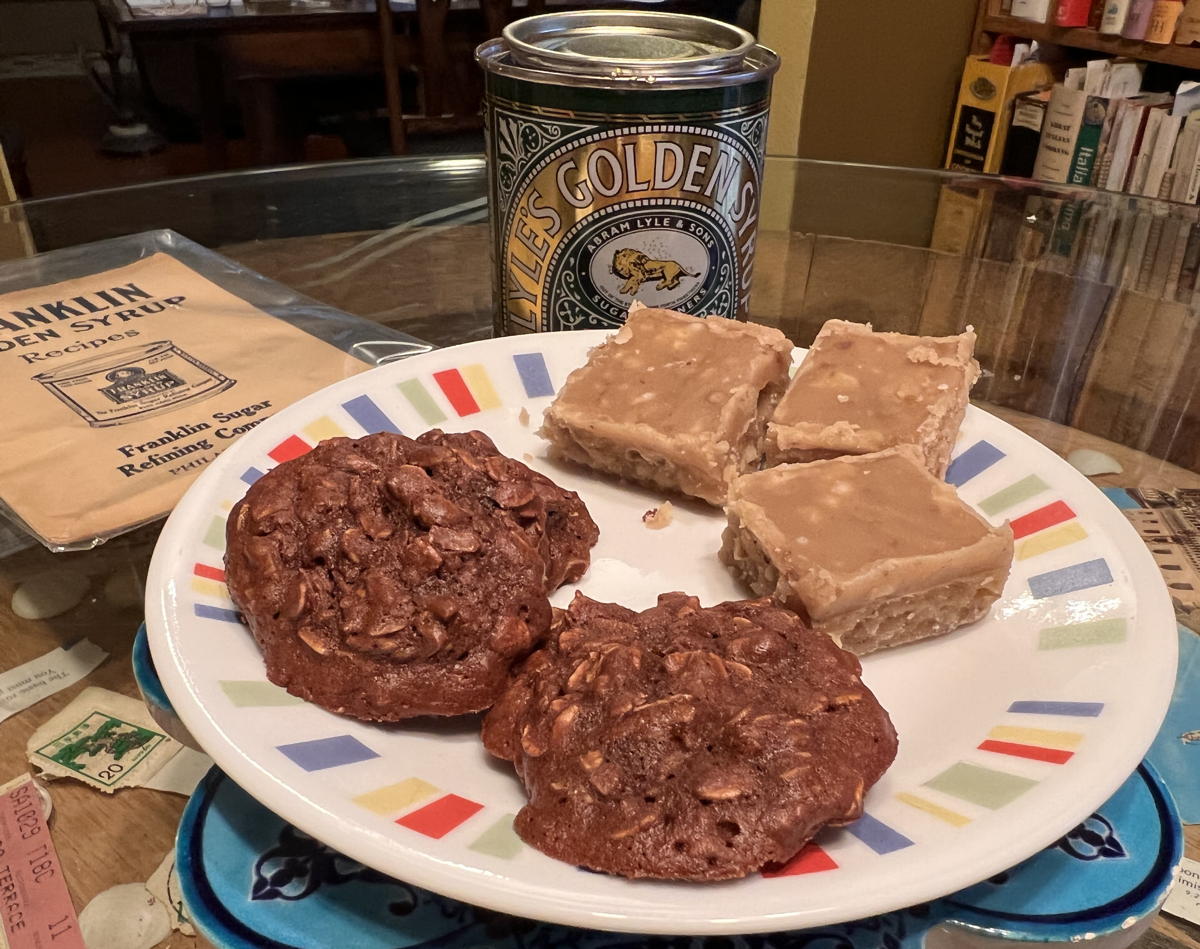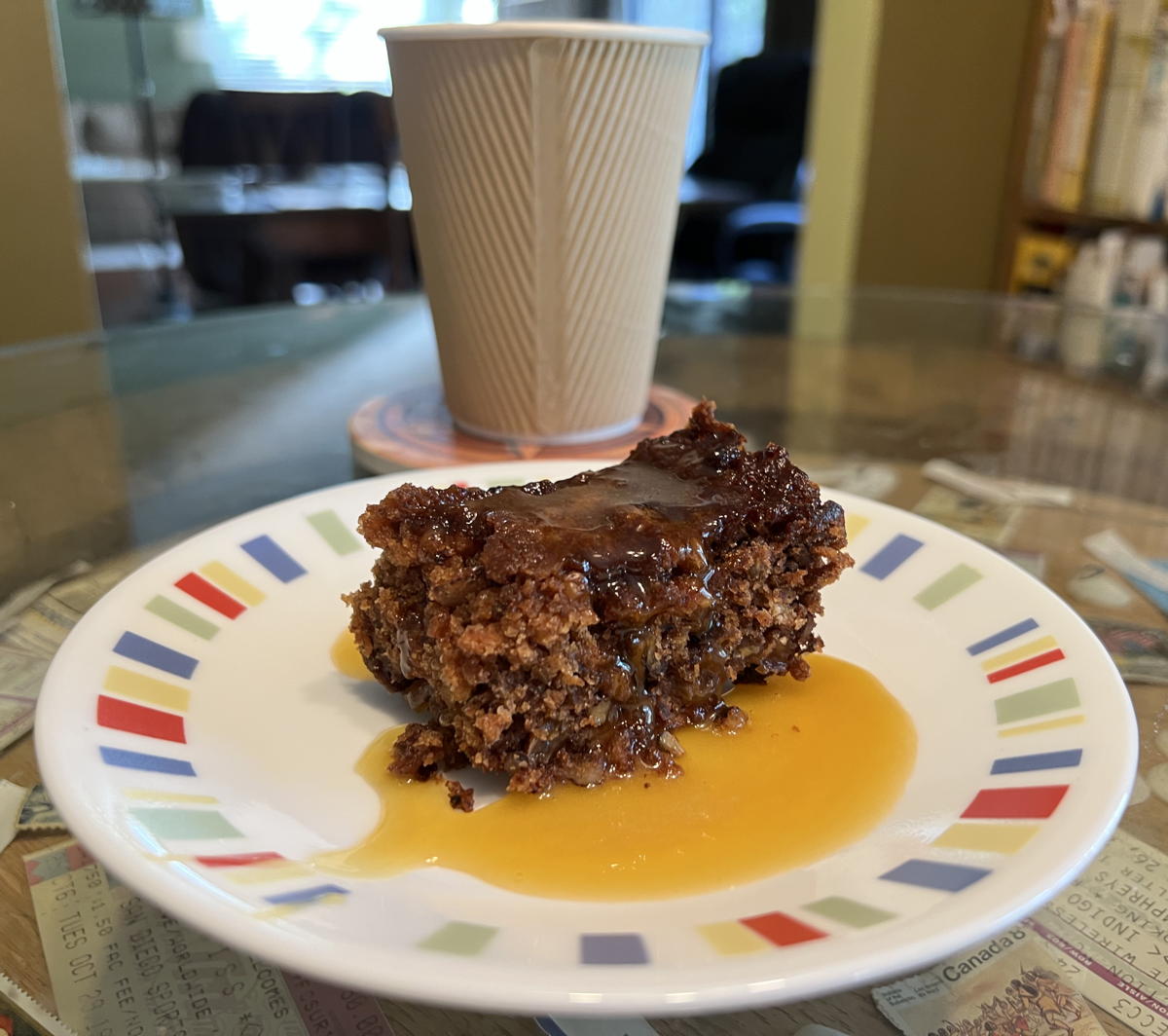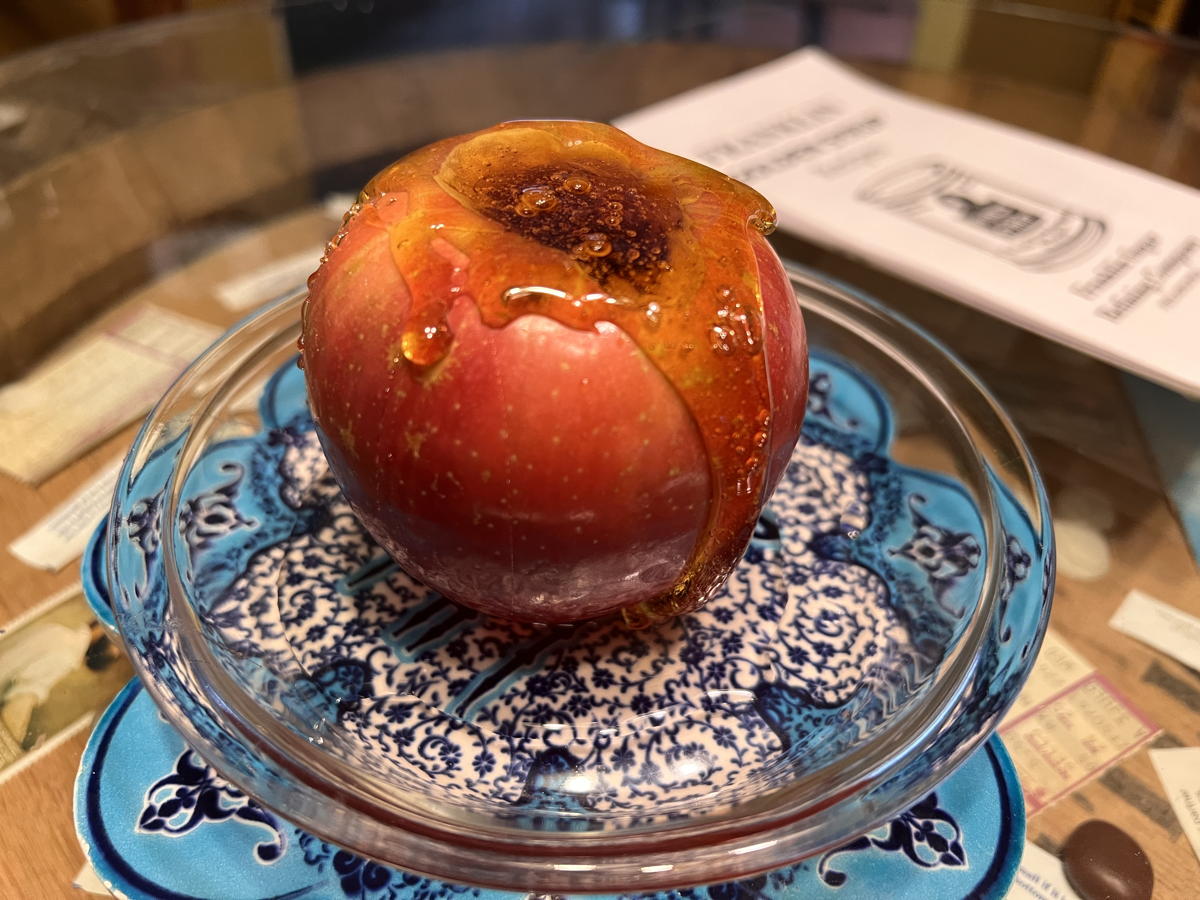Franklin Golden Syrup Recipes

The chocolate oat cakes are a cross between baked oatmeal cookies and unbaked oatmeal candies.
I recently bought an old Franklin Golden Sugar Refining Company cookbook—a pamphlet, really—from about 1910. The Franklin Sugar Refining Company of Philadelphia was one of the biggest, if not the biggest, sugar refineries in the United States—and probably the world. They don’t exist today; they’re just a side-note to a company that itself doesn’t exist. Their cane syrup doesn’t exist either. Today, most syrup for baking is made from corn instead of cane.
I didn’t realize when I bought this book that golden syrup was cane syrup. I especially didn’t know that golden syrup was a special kind of cane syrup, one that’s difficult to find nowadays except in specialty stores and through mail order. But I decided to go all the way—so many of the recipes mention the unique flavor of golden syrup that I decided to test them using it. I bought Lyle’s Golden Syrup as a substitute for Franklin’s.
Golden syrup has a wonderful caramel flavor. If this is what golden syrup used to be—and from the description of some of the recipes, I’m pretty sure it is—it’s sad that it isn’t more available. It has a wonderful creamy caramel flavor great not just for baking but also for pancakes and waffles.
There are surprisingly few histories of golden syrup online. As I write this, the Wikipedia entry is barely more than a stub. The Lyle’s page and most British pages about golden syrup focus on Lyle’s, not on the syrup itself.
Franklin Golden Syrup Recipes (ePub ebook file, 582.8 KB) is a very short collection of recipes. Unlike other branded syrup recipe books I’ve seen, it focuses exclusively on baked goods and candies. There’s nothing here about using the syrup on hams or in casseroles. I’ve also made it available as a paperback flipbook.
Golden syrup used to be much less expensive. It was a byproduct of the process of creating sugar from cane. I have a suspicion that the reason it’s no longer available is that it’s no longer a byproduct of the cane-to-sugar process. Golden syrup was very sweet; there must have been a lot of sugar still available for extraction that was being wasted in any process that produced golden syrup as a byproduct.
The age of the pamphlet is reflected in the names of some of the recipes. “Franklin Cakes” and “Chocolate Oat Cakes” are both what we would today call cookies. The word cookie comes from the word for cake, and I suspect the term was used more interchangeably in the past. The terminology also reflects older cookbooks. Franklin Cakes are baked in “a hot oven” and Chocolate Oat Cakes in “a moderate oven.” In terminology I’ve not heard before in older cookbooks, the recipes for Devil’s Food Cake and Fruit Cake call for “a very moderate oven”, which appears to be the same as a moderately slow oven, or about 325°.
Some recipes use even older terminology. Most of the recipes call for a specific amount, in teaspoons or fractions of a teaspoon, for baking soda; similarly for butter. But the Franklin Peanut Bars recipe calls for “soda the size of a pea”. The Chocolate Fudge and the Franklin Golden Syrup Kisses each call for “butter the size of an egg”. These are terms I’m familiar with from 19th century recipes, not 20th century recipes.
The recipes do, however, always provide the desired temperature for candy recipes along with the description of how the hot syrup should behave in water.
Something else I’ve seen only in 19th century cookbooks is that the amount of flour is much like the temperature of sugar: it’s done to feel rather than to volume. The lack of an amount of flour in the Ginger Cookies and the Franklin Cakes is not a typo. The recipes direct the baker on the initial amount in the instructions, and then specifies a desired consistency to gauge how much more flour gets added. I’m guessing that flour was much more variable then than now in how it absorbed liquids, requiring that bakers pay more attention to feel than to amounts.
The Fruit Cake recipe and the Franklin Peanut Bars recipe call for “Franklin Old Fashioned Brown Sugar”. According to the Michigan State University library’s guess, this is a 1910 cookbook. I’m always amazed at the use of “old-fashioned” in… old-fashioned cookbooks. What did old-fashioned mean to them in 1910? Is it just that it was brown sugar instead of white? “Franklin Old Fashioned Brown Sugar” is the only kind of brown sugar called for in the recipe book. Or was something else about the sugar different? Some modern recipes refer to dark brown sugar as old-fashioned brown sugar, for example.

Mixed with egg and butter, the syrup is very good on bread pudding.
When I read the Vanilla Ice Cream recipe I initially did a double-take.
Turn into the freezer can and freeze in the usual manner. When frozen remove the dasher; press cream down in can and repack freezer, letting it stand for three or four hours to “ripen”.
A can and dasher are parts of an ice cream churn. I’ve always thought of freezer churns as modern tools, because I normally only see instructions for crank-turned ice cream freezers in modern recipes. My early cookbooks all call for putting ice cream in the freezer of your refrigerator rather than using a churn.
But this pamphlet predates all of those early cookbooks. They were selling refrigerators with built-in freezers. When Franklin Golden Syrup Recipes came out in 1910, there were no home refrigerator/freezers. Those old-fashioned-looking ice cream churns that I remember from the seventies were probably trying to look like churns from the period this pamphlet was published. My guess is that ice cream churns fell out of favor as home freezers became ubiquitous and enjoyed a temporary resurgence during the seventies.
The recipes themselves are unique, and not just for the unique flavor of golden syrup. I managed to find some Lyle’s Golden Syrup at a homebrew supply store; Lyle’s is probably the most commonly-available golden syrup today. It tastes like caramel, and, judging from the description of some of these recipes, so did Franklin Golden Syrup. Here’s the description of the Franklin Caramel Sauce, for example, cooked with an egg and butter over a double boiler:
This sauce has a delightful caramel-like flavor but does away with the usual trouble of caramelizing the sugar.
I tried this as a sauce for bread pudding, and it does indeed have a “delightful caramel-like flavor”.
The first recipe I made were the Chocolate Oat Cakes. They’re oatmeal cookies, but of a kind I haven’t had before. They’re sort of halfway between normal baked oatmeal cookies and stovetop unbaked oatmeal cookies. They’re very good, but I find the texture odd because I expect one or the other. The chocolate also overpowers the flavor of the golden syrup.

These “Franklin Cakes” are cake-like cookies.
For my second recipe I tried Walnut Creams. They make full use of golden syrup’s flavor, with only vanilla and walnuts added for extra flavoring. It’s a creamy fudge, and a very, very good fudge. Probably, technically, it isn’t fudge because it contains no milk or other dairy, but it has all the texture and consistency of good fudge.
The Franklin Baked Apple is a perfect use for golden syrup. All it takes is partially coring an apple and filling the pocket with syrup, then baking. I’d already noticed when eating the Walnut Creams that the caramel flavor of golden syrup goes well with apples, so this was an obvious combination.
I’ve both scanned and retyped this book, and I’ve made four copies available for download, as well as made a print copy available for order if you prefer print as I do:
- A scan of the inside (JPEG Image, 705.4 KB) and the outside (JPEG Image, 700.1 KB) of the pamphlet as it actually appears.
- The scan broken into a series of pages (PDF File, 4.1 MB).
- A retyped version for printing (PDF File, 484.4 KB).
- The retyped version for ebook readers (ePub ebook file, 582.8 KB).
- A flip book of both the retyped version and the facsimile on Lulu.com
The only change I’ve made to the text is to clarify that the Franklin XXXX Sugar called for in the Franklin Hard Sauce is confectioners’ sugar. Here are some more notes you may find helpful:
- The Franklin Baked Apples need about 45 minutes to an hour at 375°.
- For the Walnut Creams recipe instructions to “Beat until it begins to thicken”, I beat until it dropped to about 190° using a laser thermometer. The walnut creams, basically a vanilla fudge with walnuts, are especially good with apples or applesauce. I suspect it’s the caramel.
- The Franklin Apple Pie probably needs as its moderate oven a 375° temperature. It may also need modern apples to be cut into sixteenths instead of eighths. Interestingly, there is no flour or starch to absorb the liquid of the apples, and it turned out fine. I did have to spoon up a little juice after cutting the first slice, but the juice didn’t keep refilling the empty space like it does in other pies that haven’t had the juice absorbed by something. It may be something about the recipe, or it might just be the apples I used.
This is a fascinating look at a once-common ingredient. As I wrote earlier, when I bought the book I didn’t realize that golden syrup was a special kind of cane syrup; I just thought it was Franklin’s name for their particular cane syrup. I expected to make all of these recipes with corn syrup. And that probably would have been fine. But for recipes like the Walnut Creams, the flavor that makes these recipes special would have been lost.
I’d love to see more people start to use golden syrup again. It has a unique flavor that’s not easily duplicated. Although you could probably come close by adding caramel extract to corn syrup, I don’t think it would be the same.

Franklin Walnut Creams
Servings: 24
Preparation Time: 45 minutes
Franklin Golden Syrup Recipes (PDF File, 484.4 KB)
Ingredients
- ⅔ cup Franklin Golden Syrup
- 2 cups Franklin Granulated Sugar
- ½ cup water
- 1½ tsp vanilla
- ¾ cup coarsely chopped English walnuts
Steps
- Boil the syrup, sugar, and water to 256° (soft, firm ball).
- Remove from heat and grain by rubbing on the sides of the pan with a spoon, beating until it begins to thicken.
- Mix in the walnuts and vanilla.
- Pour into a buttered pan and cut into squares, or pour onto wax paper in the form of pralines.
In response to Vintage Cookbooks and Recipes: I have a couple of vintage cookbooks queued up to go online.
downloads
- Franklin Golden Syrup Recipes at Lulu storefront (paperback)
- “Golden Sugar was a magical byproduct of making sugar from cane, and the Franklin Sugar Refining Company was one of the biggest sugar producers in the United States. This 1910 Franklin Golden Syrup Recipes book collects several candies, cakes, cookies, and desserts all of which use golden syrup and its wonderful caramel flavor.” This flipbook contains both a retyped version for easier reading and a facsimile of the original.
- Franklin Golden Syrup Recipes (ePub ebook file, 582.8 KB)
- A retyped ePub of the Franklin Sugar Refining Company’s Franklin Golden Syrup Recipes pamphlet/cookbook.
- Franklin Golden Syrup Recipes (PDF File, 484.4 KB)
- A retyped PDF of the Franklin Sugar Refining Company’s Franklin Golden Syrup Recipes pamphlet/cookbook.
- Franklin Golden Syrup Recipes (facsimile) (PDF File, 4.1 MB)
- The original format of the Franklin Sugar Refining Company’s pamphlet, Franklin Golden Syrup Recipes, rearranged from a pamphlet to a book.
- Franklin Golden Syrup Recipes (inside) (JPEG Image, 705.4 KB)
- The inside of the Franklin Sugar Refining Company’s pamphlet, Franklin Golden Syrup Recipes.
- Franklin Golden Syrup Recipes (outside) (JPEG Image, 700.1 KB)
- The outside of the Franklin Sugar Refining Company’s pamphlet, Franklin Golden Syrup Recipes.
Franklin Sugar Refining Company
- American Sugar Refining Company at Wikipedia
- “The American Sugar Refining Company (ASR) was the largest American business unit in the sugar refining industry in the early 1900s. It had interests in Puerto Rico and other Caribbean locations, and operated one of the world's largest sugar refineries, the Domino Sugar Refinery in Brooklyn, New York.”
- Once upon a time, the world was sweet on Philly’s sugar industry
- “At one time, the Franklin Sugar Refinery was one of the largest in the world, controlling 90 percent of America’s sugar.”
- What was “Old Fashioned Brown Sugar” in 1910? at Seasoned Advice (Stack Exchange)
- Modern authors seem to use old fashioned to refer to dark brown sugar, although usually as an aside. Older authors seem to have multiple definitions of old-fashioned brown sugar.
golden syrup
- 1840 Earliest mention of Golden Syrup
- “Because it was cheaper than jam and easily transported in tins, golden syrup became a substitute for butter in the bush. Outback stations and shearers’ cooks bought their supply in 70lb (32kg) tins.”
- Golden syrup at Wikipedia
- “Golden syrup or light treacle is a thick, amber-coloured form of inverted sugar syrup made by the process of refining sugar cane or sugar beet juice into sugar, or by treatment of a sugar solution with acid.”
- Lyle’s Golden Syrup
- “Lyle’s Golden Syrup, unchanged since 1883. Ideal for baking and toppings, and a perfect companion for pancakes and porridge.”
ice cream
- Ice cream from your home freezer
- You can make great ice cream with whole eggs, egg yolks, and egg whites. You can even make it without eggs at all. All you need is syrup and cream—and a refrigerator with a freezer or a standalone home freezer.
- Revolution: Home Refrigeration
- Nasty, brutish, and short. Unreliable power is unreliable civilization. When advocates of unreliable energy say that Americans must learn to do without, they rarely say what we’re supposed to do without.
More cookbooks
- Cookbook publication year estimates I have made
- When I acquire a cookbook without a publication or copyright year, I use the advertisements and contributors to make a stab at the likely year of publication. This page provides those guesses in case it helps you date your own books.
- Refrigerator Revolution Revisited: 1937 Kitchen-Proved
- Refrigerators started to take off during Prohibition, and became ubiquitous following World War II. This Westinghouse refrigerator manual and cookbook gives us a glimpse at home refrigerator/freezers in the Great Depression.
- Four New Ices and an Ice Cream Cookery
- Philadelphia Ice Cream, Walnut Nougat, Lemon Cream Sherbet, and Cranberry Ice. Four more new no-churn ice creams and desserts for Summer 2025. And, a book collecting all my favorite no-churn ice creams if you’re interested!
- My Year in Food: 2024
- From Italy, to San Diego, to Michigan, and many points in between; and from 1876 up to 2024 with stops in the 1920s, this has been a great food year.
- Mrs. Winslow’s Domestic Receipt Book for 1876
- If this is what people were eating in 1876, they were eating very well. From coconut pie to molasses gingerbread to tomato jam, these are great recipes—albeit requiring some serious interpretation.
- 72 more pages with the topic cookbooks, and other related pages


